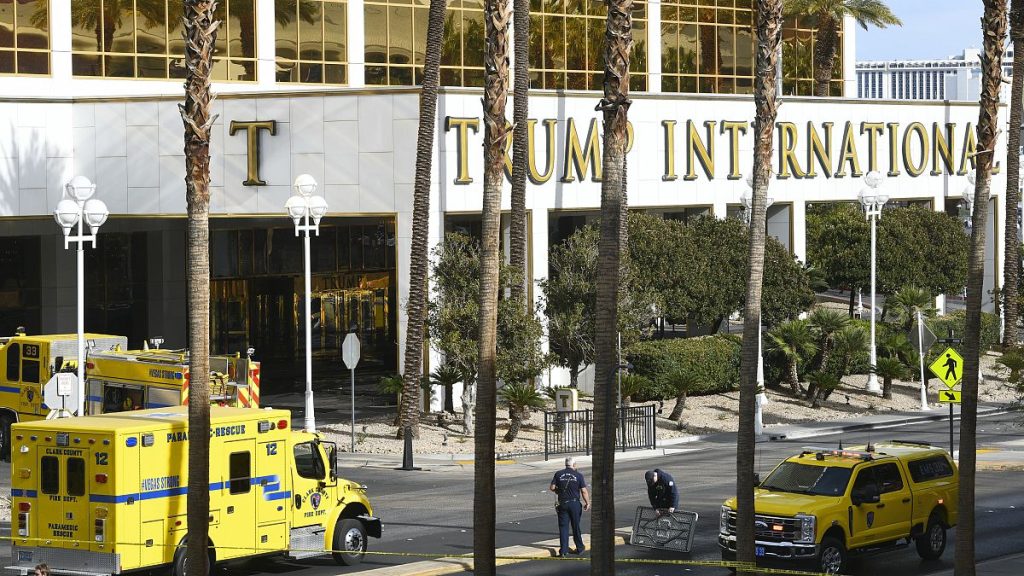A devastating explosion involving a Tesla Cybertruck rocked the vicinity of Donald Trump’s International Hotel in Las Vegas late Wednesday, leaving one person dead and seven others injured. The incident immediately sparked a multi-faceted investigation encompassing forensic analysis, terrorism inquiries, and the identification of the individual who rented the vehicle. Initial findings revealed that the bed of the futuristic pickup truck was packed with a volatile combination of firework mortars and camp fuel canisters, pointing towards a deliberate act. The individual who perished in the explosion was inside the truck at the time. Authorities are working to confirm whether the deceased is the same person who rented the Cybertruck via the peer-to-peer car rental app, Turo, in Colorado. This individual is known to law enforcement, but their identity remains withheld pending the outcome of this verification. The possibility of a terrorism link is also under active investigation, adding another layer of complexity to the unfolding situation.
The investigation benefitted from a crucial piece of evidence: video footage from Tesla charging stations. Tesla CEO Elon Musk, who has recently aligned himself with Trump and joined his inner circle, provided access to this footage, enabling authorities to trace the Cybertruck’s journey. The vehicle arrived in Las Vegas around 7:30 am local time and, approximately an hour later, entered the valet area of the Trump International Hotel. The explosion occurred within a mere 15 to 20 seconds of the truck’s arrival in the valet area, suggesting a pre-planned detonation. The rapid sequence of events reinforces the suspicion of deliberate action and fuels the investigation into potential motives, including the possibility of a targeted attack.
Musk publicly addressed the incident via a post on X (formerly Twitter) on Wednesday afternoon. He emphatically stated that the explosion was unrelated to the Cybertruck itself, attributing the blast to “very large fireworks and/or a bomb” carried in the truck’s bed. He further emphasized that all vehicle telemetry readings were normal at the time of the detonation, effectively ruling out any mechanical malfunction or inherent vehicle defect as a contributing factor. This statement serves to distance Tesla from any potential liability and reinforces the narrative that the explosion was a result of external factors. Musk’s prompt and decisive communication underscores the high-stakes nature of the situation, given the involvement of his company’s vehicle in a high-profile incident near a prominent figure’s property.
The timing of the explosion, in close proximity to a property owned by the then-President-elect Donald Trump, immediately raised concerns about potential political motivations or targeted violence. The fact that the explosion occurred in Las Vegas, a major tourist destination, further amplified anxieties about the potential for broader public harm. The swift response from law enforcement, coupled with the active pursuit of a terrorism link, reflects the seriousness with which authorities are treating the incident. The investigation is unfolding amidst a backdrop of heightened political tensions and underscores the vulnerability of public spaces to acts of violence.
The use of a rented vehicle in the incident raises critical questions about the security protocols and verification processes employed by car-sharing platforms like Turo. The fact that the renter was known to law enforcement, yet still able to rent a vehicle potentially capable of transporting hazardous materials, highlights potential vulnerabilities in the system. This incident could prompt a review and potential tightening of regulations governing peer-to-peer car rentals, with a focus on enhanced background checks and stricter monitoring of renter activities. The case underscores the challenges of balancing accessibility with security in the sharing economy.
The explosion near Trump’s Las Vegas hotel serves as a stark reminder of the potential for everyday objects, like vehicles, to be weaponized. The incident highlights the evolving nature of security threats and the need for vigilance in public spaces. The investigation continues, with authorities meticulously piecing together the events leading up to the explosion, exploring all possible motives, and working to determine the full extent of the perpetrator’s intentions. The findings will undoubtedly have implications for security protocols, car rental policies, and the broader public discourse on mitigating the risks of similar incidents in the future.














